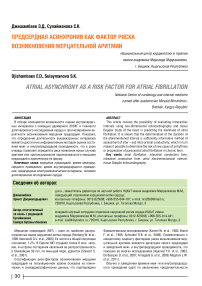Предсердная асинхрония как фактор риска возникновения мерцательной аритмии
Автор: Джишамбаев Э.Д., Сулайманова С.К.
Журнал: Евразийский кардиологический журнал @eurasian-cardiology-journal
Рубрика: Оригинальные статьи
Статья в выпуске: 1, 2016 года.
Бесплатный доступ
В обзоре освещаются возможности оценки внутрисердеч-ных интервалов с помощью двумерного ЭХОКГ и тканевого допплеровского исследования сердца в прогнозировании вероятности возникновения мерцания предсердий. Показано, что определение длительности вышеуказанных интервалов является достаточно информативным методом оценки состояния меж- и внутрипредсердной проводимости, что в свою очередь позволяет определять риск появления новых случаев аритмии или прогрессирования пароксизмального мерцания предсердий в хроническую ее форму.
Мерцание предсердий, время межпред-сердного проведения, время внутрипредсердного проведения, предсердные электромеханические интервалы, тканевое допплеровское исследование сердца
Короткий адрес: https://sciup.org/14342812
IDR: 14342812
Список литературы Предсердная асинхрония как фактор риска возникновения мерцательной аритмии
- Feinberg W.M., Blackshear J.L., Laupacis A. et al. Prevalence, age distribution and gender of patients with atrial fibrillation: analysis and implications. Arch. Intern. Med. 1995; 155:469-473.
- Naccarelli G.V., Varker H., Lin J., Schulman K.L. Increasing prevalence of atrial fibrillation and flutter in the United States. Amer. J. Cardiol//2009. -v.104. -p.1534-1539.
- Stewart S., Hart C.L., Hole D.J., McMurray J.J. Population prevalence, incidence and predictors of atrial firillation in the Renfrew/Paisley study//Heart. -2001. -v.86. -p.516-521.
- Kannel W.B., Abbott R.D., Savage D.D., McNamara P.M. Epidemiologic features of chronic atrial fibrillation: the Framingham study. N. Engl. J.Med. 1982; 306:1018-1022.
- Brand F.N., Abbott R.D., Kannel W.B., Wolf P.A. Characteristics and prognosis in lone atrial fibrillation: 30-year follow-up in the Framingham study. JAMA 1985; 254:3449-3453.
- Schnabel R.B., Sullivan L.M., Levy D. et al. Development of a risk score for atrial fibrillation (Framingham Heart Study): a community-based cohort study//Lancet. -2009. -v.373 (9665). -p.739-745.
- Agarwal Y.K., Aronow W.S., Levy J.A., Spadick D.H. Association of interatrial block with development of atrial fibrillation//Amer. J. Cardiol. -2003. -v.91. -p.882.
- De BacquerD., Willekens J., De BackerG. Long-term prognostic value of P-wave characteristics for the development of atrial fibrillation in subjects aged 55 to 74 years at baseline//Amer. J. Cardiol. -2007. -v.100. -p.850-854
- Arriagada G., Berruezo A., Mont L. et al. Predictors of arrhythmia recurrence in patients with lone atrial fibrillation//Europace. -2008. -v.10 (1). -p.9-14.
- Magnani J.W., Johnson V.M., Sullivan L.M. et al. P wave duration and risk of longitudinal atrial fibrillation in persons > 60 years old (from the Framingham Heart Study)//Amer. J. Cardiol. -2011. -v.107 (6). -p.917-921
- Buxton A.E., Josephson M.E. The role of P wave duration as a predictor of postoperative atrial arrhythmias. Chest 1981; 80:68-73.
- Engel T.R., Vallone N., Windle J. Signal-averaged electrocardiograms in patients with atrial fibrillation or flutter. Amer. Heart J. -1988. -115 (3). -p. 592-597.
- Fukunami M., Yamada T., Ohmori M. et al. Detection of patients at risk for paroxysmal atrial fibrillation during sinus rhythm by P wave triggered signal-averaged electrocardiogram. Circulation 1991; 83(1): 162-169.
- Dilaveris P.E., Jialafos J.P. P-wave dispersion: a novel predictor of paroxysmal atrial fibrillation. Ann. Noninvasive Electrocardiol. 2001; 6:159-165.
- Cozma D., Kalifa J., Pescariu S. et al. Can simple Doppler measurements estimate interatrial conduction time? PACE 2003; 26: 436-439.
- Deniz A., Sahiner L., Aytemir K. et al. Tissue Doppler echocardiography can be a useful technique to evaluate atrial conduction time//Cardiol. J. -2012. -v.19 (5). -p.487-493.
- Merckx K.L., deVos C.B., Palmans A. and al. Atrial activation time determined by transthoracic Doppler tissue imaging can be used as an estimate of the total duration of atrial electrical activation. J. Amer. Soc. Echocardiogr. 2005; 18(9): 940-944.
- Wang K., Xiao H.B., Fugimoto S. Gibson D.G. Atrial electromechanical sequence in normal subjects and patients with DDD pacemakers. Brit. Heart J. 1995; 74:403-407.
- Omi W., Nagai H., Takamura M. et al. Doppler tissue analysis of atrial electromechanical coupling in paroxysmal atrial fibrillation. J. Amer. Soc. Echocardiogr. 2005; 18(1): 39-44.
- Rein A., O Donnell C.P., Calan S.D., Marx G.R. Tissue velocity Doppler assessment of atrial and ventricular electromechanical coupling and atrioventricular time intervals in normal subjects. Amer. J. Cardiol. 2003; 92:1347-1350.
- Sakabe K., Fukuda N., Fukuda Y. et al. Interatrial dyssynchrony on tissue Doppler imaging predicts progression to chronic atrial fibrillation in patients with non-valvular paroxysmal atrial fibrillation. Heart. 2009; 95(12): 988-993.
- Deniz A., Yavuz B., Aytemir K. et al. Intra-left atrial mechanical delay detected by tissue Doppler Echocardiography can be a useful marker for paroxysmal atrial fibrillation. Echocardiography. 2009; 26(7): 779-784.
- Roshanali F., Mandegar M.H., Yousefnia MA. et al. Prediction of atrial fibrillation via atrial electromechanical interval after coronary artery bypass grafting. Circulation 2007; 116:2012-2017.
- Antoni M.L., Bertini M., Atary J.Z. et al. Predictive value of total atrial conduction time estimated with tissue Doppler imaging for the development of new-oncet atrial fibrillation after acute myocardial infarction. Amer. J. Cardiol. 2010; 106:198-203.
- Karapinar H., Acar G., Kirma C. et al. Delayed right atrial lateral electromechanical coupling relative to the septal one can be associated with paroxysmal atrial fibrillation. Eur. Rev. Med. Pharmacol. Sci. 2013; 17(16): 2172-2178.
- Ari H., Ari S., Akkaya M. et al. Predictive value of atrial electromechanical delay for atrial fibrillation recurrence//Cardiol. J. -2013. -v.20 (6). -p.639-647.
- Cui Q., Zhang W., Wang H/et al. Assessment of atrial electromechanical coupling and influential factors in nonrheumatic paroxysmal atrial fibrillation. Clin.Cardiol. 2008; 31(1); 74-78.


